Đặc điểm của tham thể trong câu hành vi tiếng Việt và tiếng Anh
Bài viết này thảo luận các đặc điểm của tham thể trong câu hành vi tiếng Anh và tiếng Việt bằng
cách mô tả, lý giải cấu trúc từ vựng-ngữ pháp, nghĩa ý niệm theo khung lý thuyết ngữ pháp chức
năng của Halliday và Matthiessen (2004); Martin et al (1997) và so sánh đối chiếu theo 3 nội dung
này. Chúng tôi lưu ý đến vấn đề từ vựng-ngữ pháp, nghĩa và sự chọn lựa ngôn từ thông qua các
lớp nghĩa của tham thể. Mỗi loại tham thể được phân tích và diễn giải theo hai bình diện: (i) cấu
trúc – theo cấp bậc và (ii) ngữ nghĩa – theo vai. Để làm sáng tỏ hơn vấn đề, chúng tôi phân tích
các đặc điểm tham thể trong câu hành vi trên cơ sở cứ liệu gồm mười sáu tiểu thuyết và truyện
ngắn tiếng Anh và tiếng Việt thế kỷ XIX và XX. Kết luận nêu bật những kết quả mới trong công
trình nghiên cứu và đề xuất giải pháp.
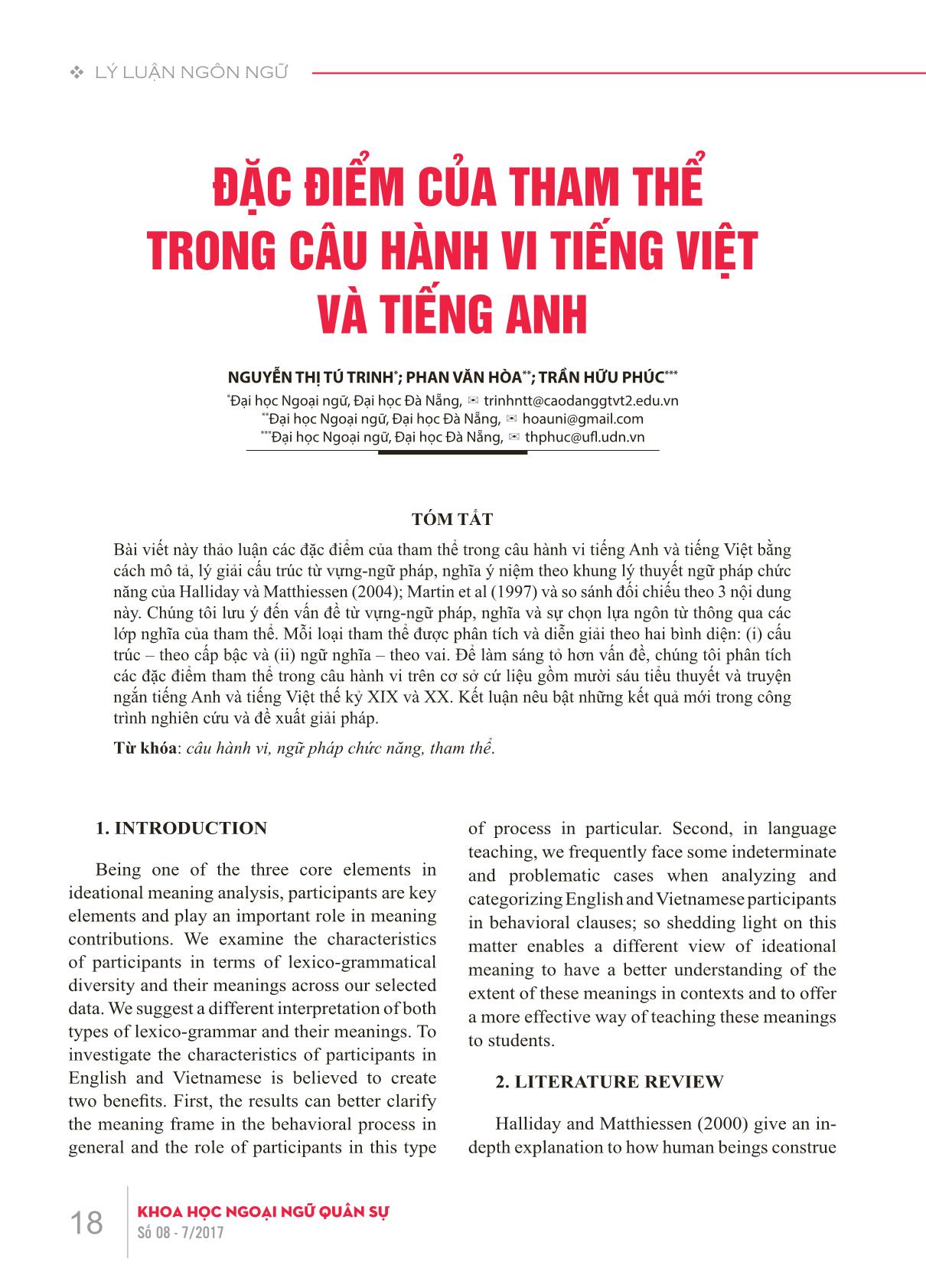
Trang 1
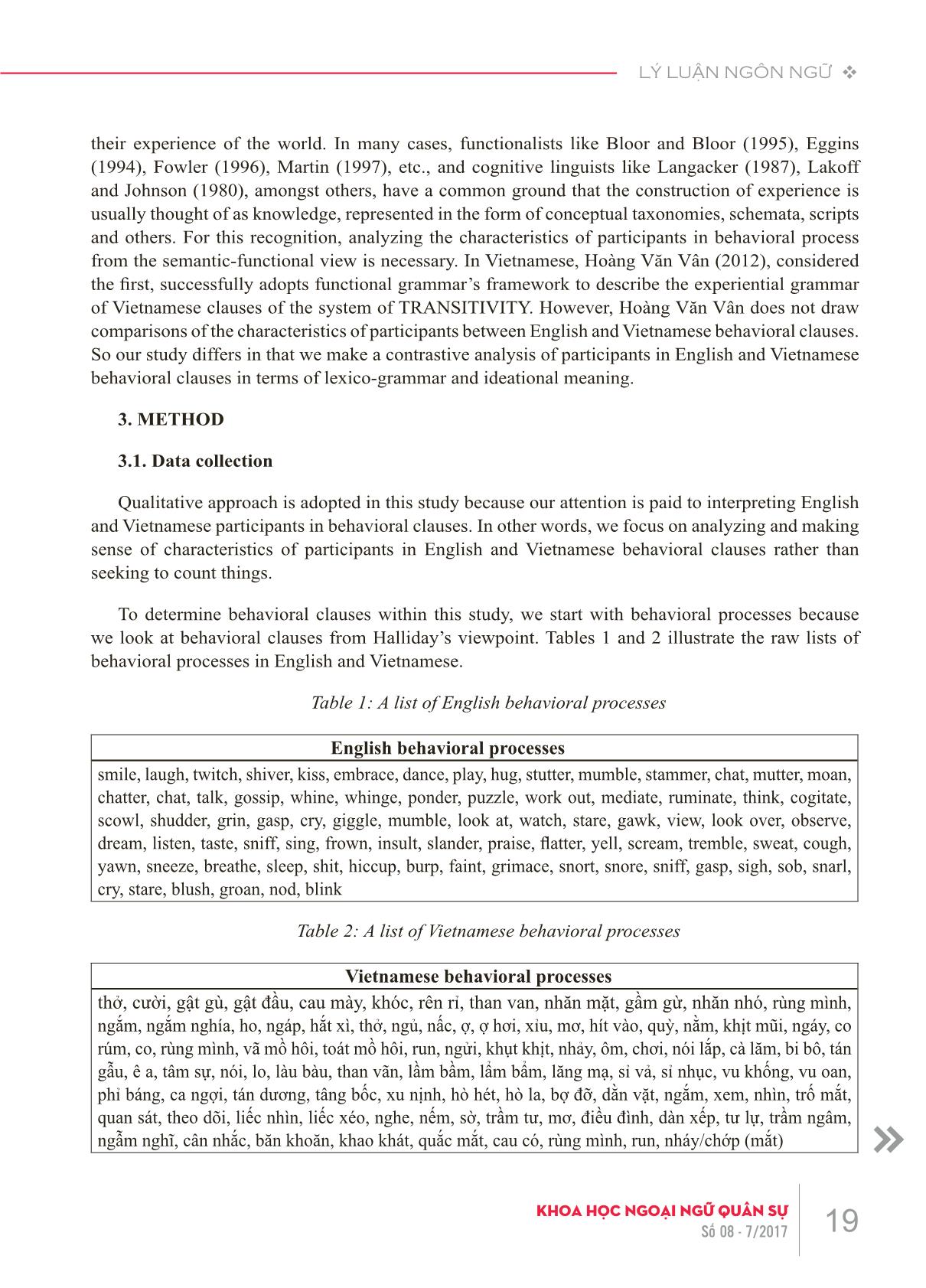
Trang 2
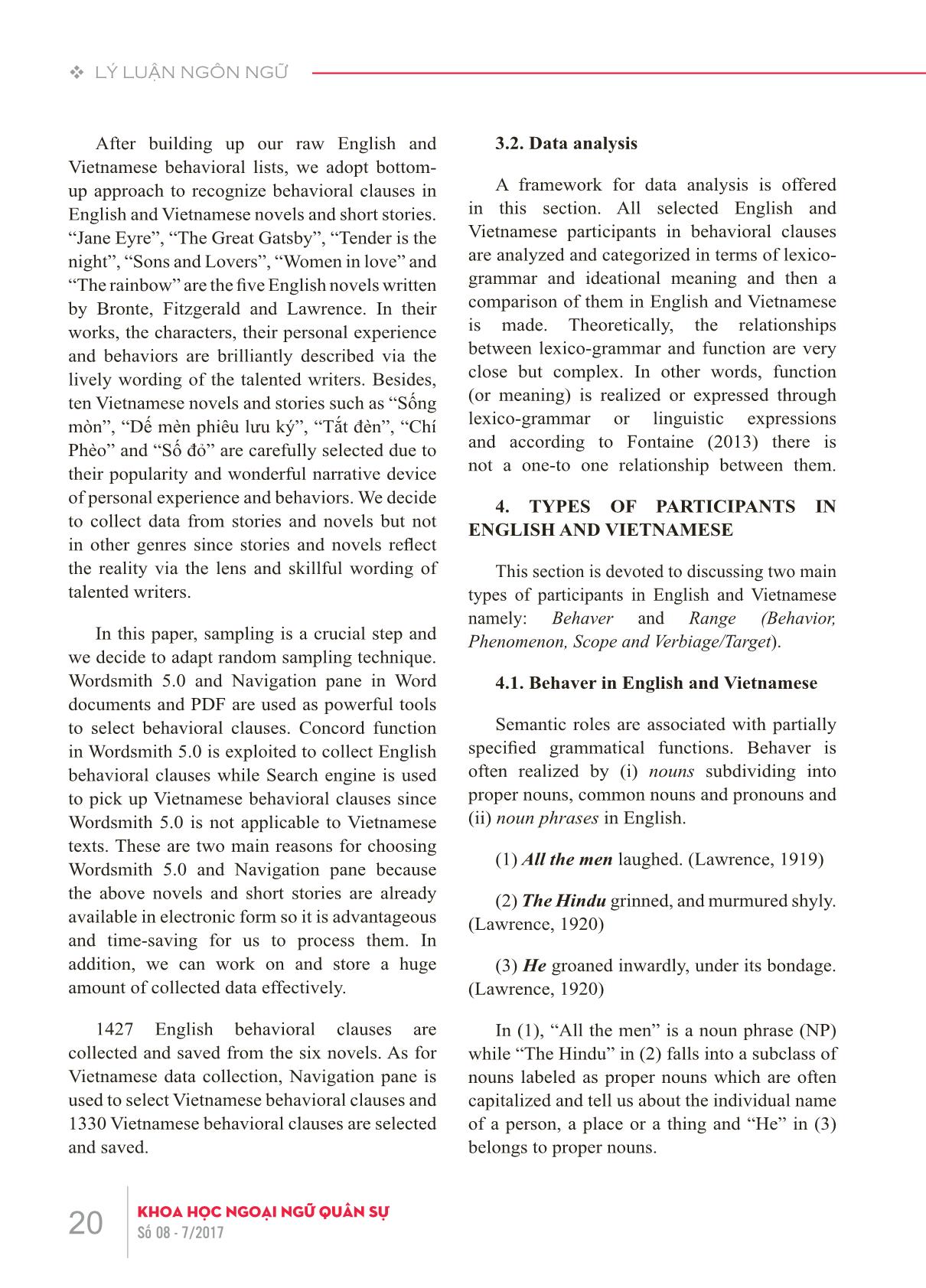
Trang 3
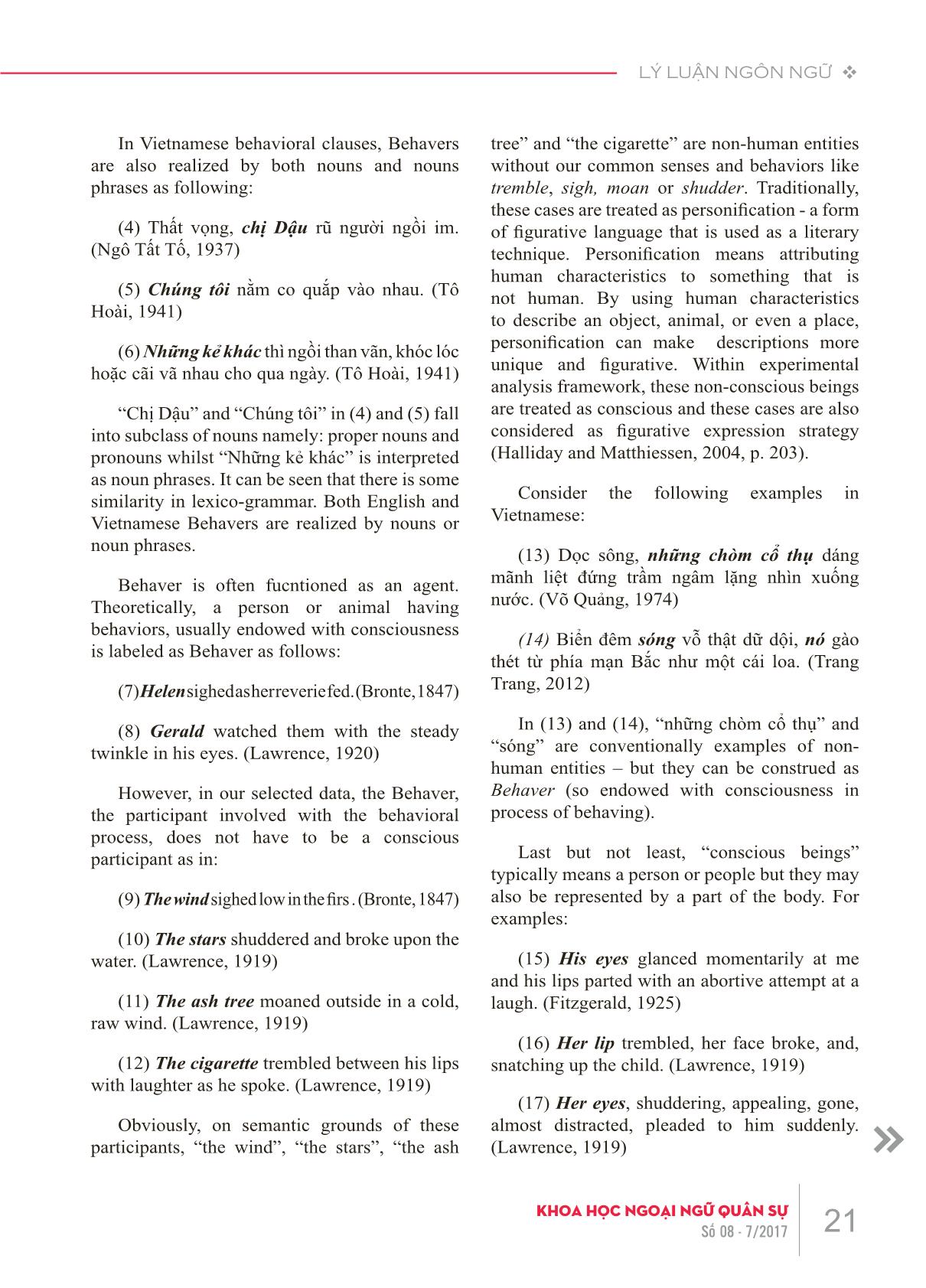
Trang 4
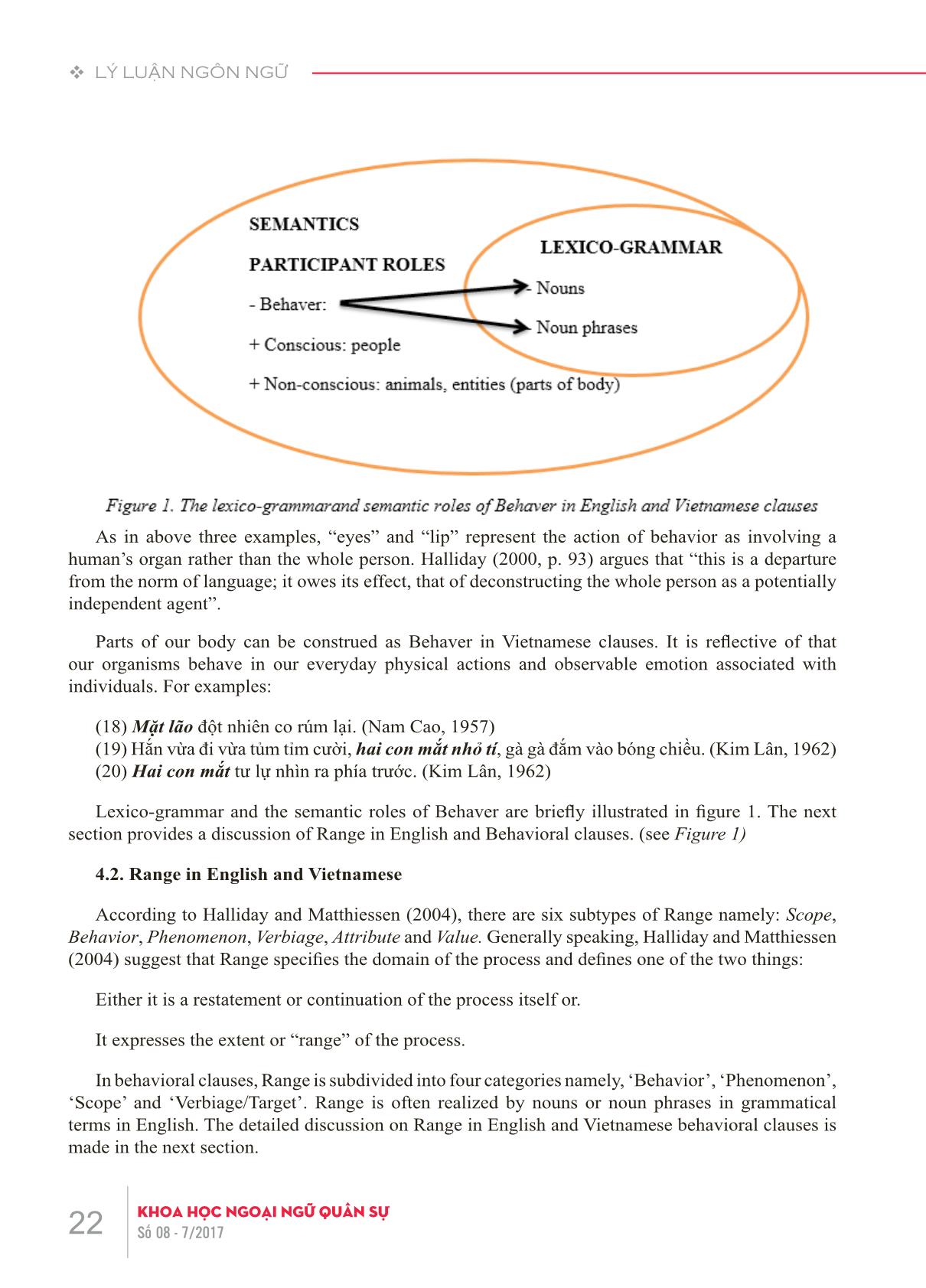
Trang 5
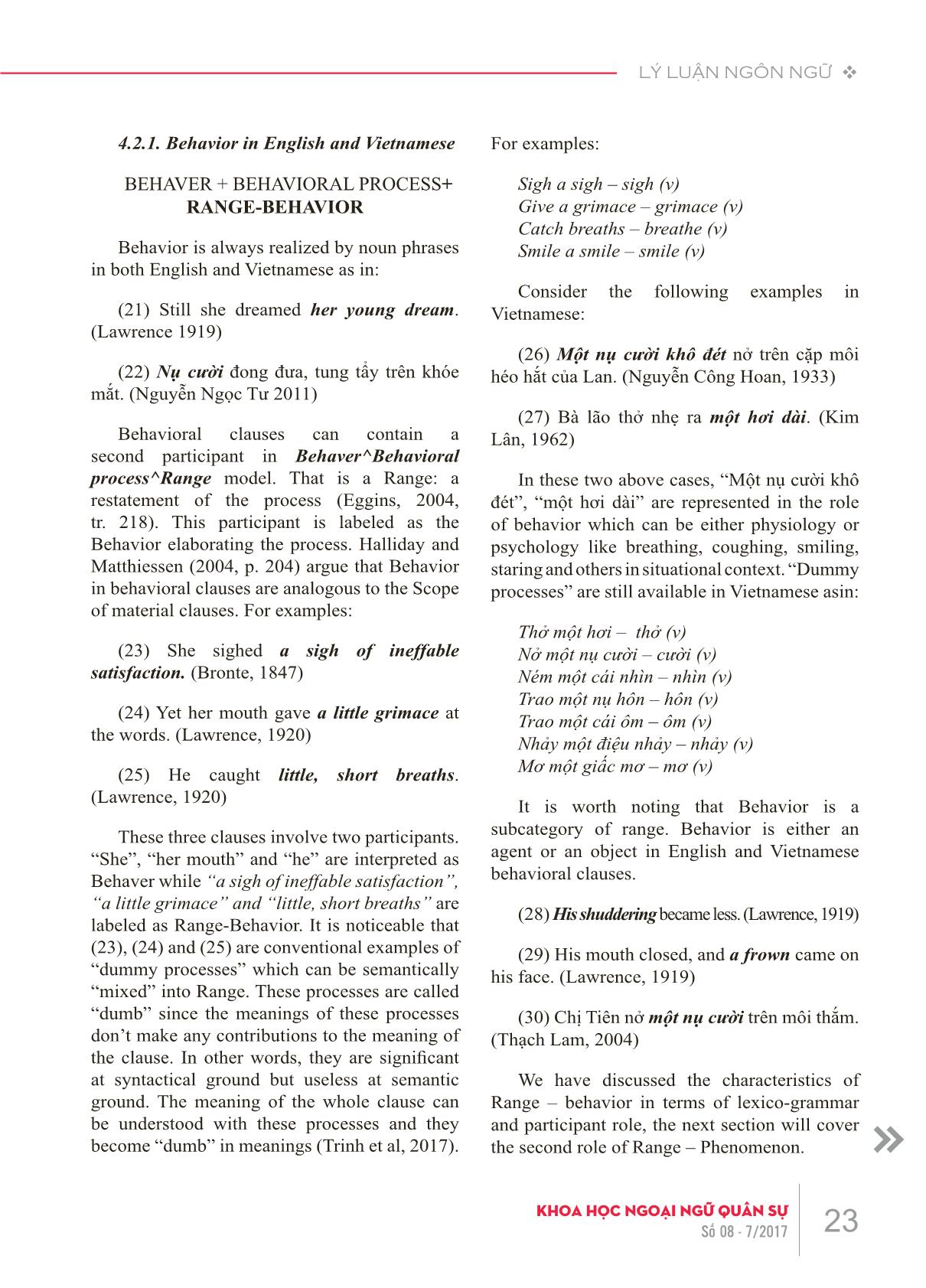
Trang 6
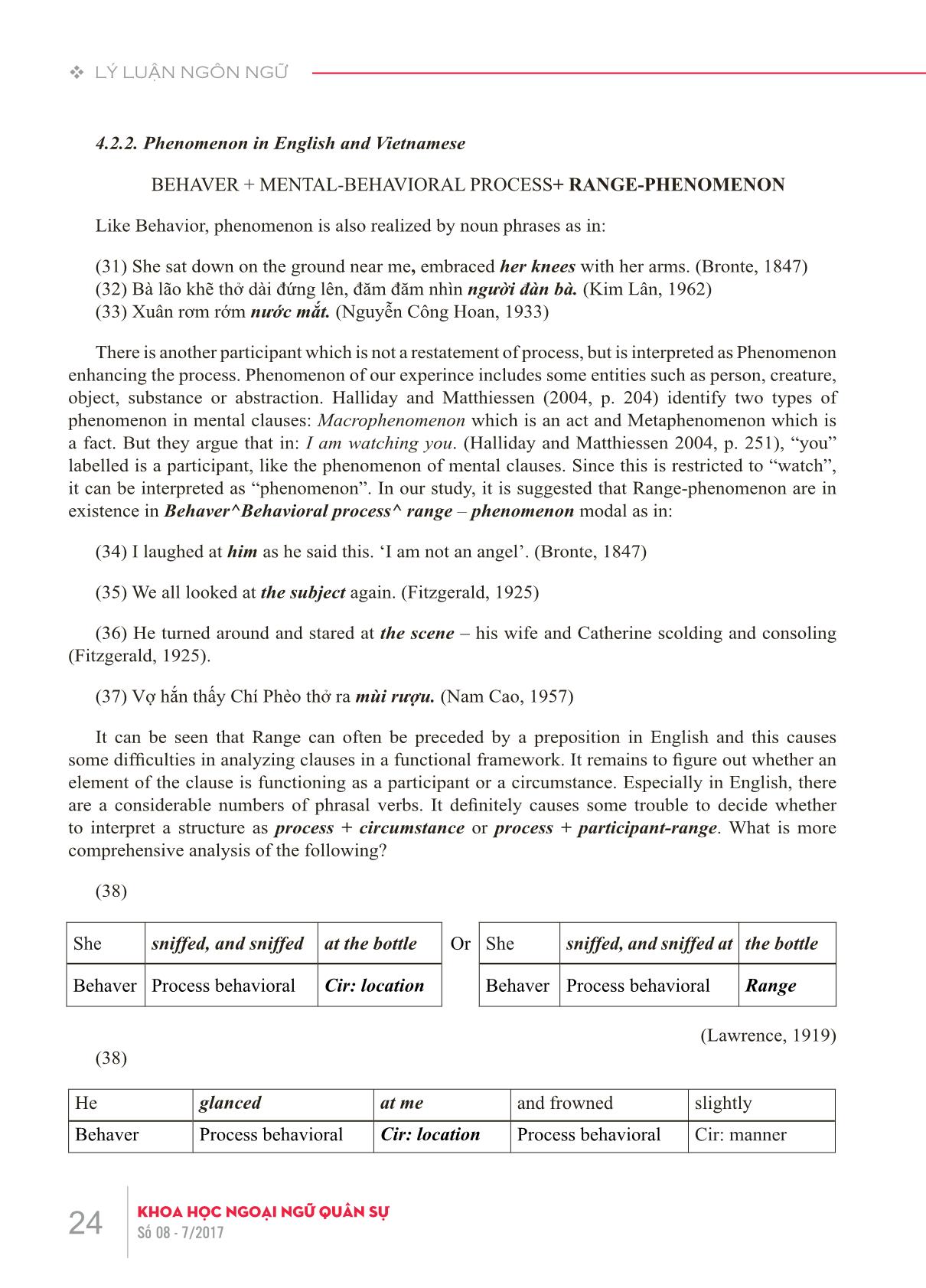
Trang 7
Tóm tắt nội dung tài liệu: Đặc điểm của tham thể trong câu hành vi tiếng Việt và tiếng Anh
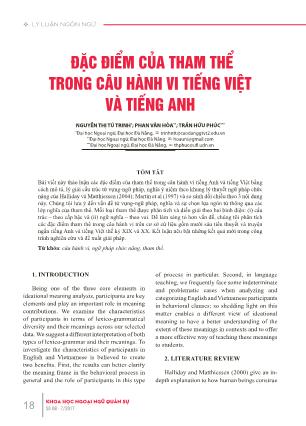
eam, tremble, sweat, cough, yawn, sneeze, breathe, sleep, shit, hiccup, burp, faint, grimace, snort, snore, sniff, gasp, sigh, sob, snarl, cry, stare, blush, groan, nod, blink Table 2: A list of Vietnamese behavioral processes Vietnamese behavioral processes thở, cười, gật gù, gật đầu, cau mày, khóc, rên rỉ, than van, nhăn mặt, gầm gừ, nhăn nhó, rùng mình, ngắm, ngắm nghía, ho, ngáp, hắt xì, thở, ngủ, nấc, ợ, ợ hơi, xỉu, mơ, hít vào, quỳ, nằm, khịt mũi, ngáy, co rúm, co, rùng mình, vã mồ hôi, toát mồ hôi, run, ngửi, khụt khịt, nhảy, ôm, chơi, nói lắp, cà lăm, bi bô, tán gẫu, ê a, tâm sự, nói, lo, làu bàu, than vãn, lầm bầm, lẩm bẩm, lăng mạ, sỉ vả, sỉ nhục, vu khống, vu oan, phỉ báng, ca ngợi, tán dương, tâng bốc, xu nịnh, hò hét, hò la, bợ đỡ, dằn vặt, ngắm, xem, nhìn, trố mắt, quan sát, theo dõi, liếc nhìn, liếc xéo, nghe, nếm, sờ, trầm tư, mơ, điều đình, dàn xếp, tư lự, trầm ngâm, ngẫm nghĩ, cân nhắc, băn khoăn, khao khát, quắc mắt, cau có, rùng mình, run, nháy/chớp (mắt) 20 KHOA HỌC NGOẠI NGỮ QUÂN SỰSố 08 - 7/2017 v LÝ LUẬN NGÔN NGỮ After building up our raw English and Vietnamese behavioral lists, we adopt bottom- up approach to recognize behavioral clauses in English and Vietnamese novels and short stories. “Jane Eyre”, “The Great Gatsby”, “Tender is the night”, “Sons and Lovers”, “Women in love” and “The rainbow” are the five English novels written by Bronte, Fitzgerald and Lawrence. In their works, the characters, their personal experience and behaviors are brilliantly described via the lively wording of the talented writers. Besides, ten Vietnamese novels and stories such as “Sống mòn”, “Dế mèn phiêu lưu ký”, “Tắt đèn”, “Chí Phèo” and “Số đỏ” are carefully selected due to their popularity and wonderful narrative device of personal experience and behaviors. We decide to collect data from stories and novels but not in other genres since stories and novels reflect the reality via the lens and skillful wording of talented writers. In this paper, sampling is a crucial step and we decide to adapt random sampling technique. Wordsmith 5.0 and Navigation pane in Word documents and PDF are used as powerful tools to select behavioral clauses. Concord function in Wordsmith 5.0 is exploited to collect English behavioral clauses while Search engine is used to pick up Vietnamese behavioral clauses since Wordsmith 5.0 is not applicable to Vietnamese texts. These are two main reasons for choosing Wordsmith 5.0 and Navigation pane because the above novels and short stories are already available in electronic form so it is advantageous and time-saving for us to process them. In addition, we can work on and store a huge amount of collected data effectively. 1427 English behavioral clauses are collected and saved from the six novels. As for Vietnamese data collection, Navigation pane is used to select Vietnamese behavioral clauses and 1330 Vietnamese behavioral clauses are selected and saved. 3.2. Data analysis A framework for data analysis is offered in this section. All selected English and Vietnamese participants in behavioral clauses are analyzed and categorized in terms of lexico- grammar and ideational meaning and then a comparison of them in English and Vietnamese is made. Theoretically, the relationships between lexico-grammar and function are very close but complex. In other words, function (or meaning) is realized or expressed through lexico-grammar or linguistic expressions and according to Fontaine (2013) there is not a one-to one relationship between them. 4. TYPES OF PARTICIPANTS IN ENGLISH AND VIETNAMESE This section is devoted to discussing two main types of participants in English and Vietnamese namely: Behaver and Range (Behavior, Phenomenon, Scope and Verbiage/Target). 4.1. Behaver in English and Vietnamese Semantic roles are associated with partially specified grammatical functions. Behaver is often realized by (i) nouns subdividing into proper nouns, common nouns and pronouns and (ii) noun phrases in English. (1) All the men laughed. (Lawrence, 1919) (2) The Hindu grinned, and murmured shyly. (Lawrence, 1920) (3) He groaned inwardly, under its bondage. (Lawrence, 1920) In (1), “All the men” is a noun phrase (NP) while “The Hindu” in (2) falls into a subclass of nouns labeled as proper nouns which are often capitalized and tell us about the individual name of a person, a place or a thing and “He” in (3) belongs to proper nouns. 21KHOA HỌC NGOẠI NGỮ QUÂN SỰSố 08 - 7/2017 LÝ LUẬN NGÔN NGỮ v In Vietnamese behavioral clauses, Behavers are also realized by both nouns and nouns phrases as following: (4) Thất vọng, chị Dậu rũ người ngồi im. (Ngô Tất Tố, 1937) (5) Chúng tôi nằm co quắp vào nhau. (Tô Hoài, 1941) (6) Những kẻ khác thì ngồi than vãn, khóc lóc hoặc cãi vã nhau cho qua ngày. (Tô Hoài, 1941) “Chị Dậu” and “Chúng tôi” in (4) and (5) fall into subclass of nouns namely: proper nouns and pronouns whilst “Những kẻ khác” is interpreted as noun phrases. It can be seen that there is some similarity in lexico-grammar. Both English and Vietnamese Behavers are realized by nouns or noun phrases. Behaver is often fucntioned as an agent. Theoretically, a person or animal having behaviors, usually endowed with consciousness is labeled as Behaver as follows: (7) Helen sighed as her reverie fed. (Bronte, 1847) (8) Gerald watched them with the steady twinkle in his eyes. (Lawrence, 1920) However, in our selected data, the Behaver, the participant involved with the behavioral process, does not have to be a conscious participant as in: (9) The wind sighed low in the firs . (Bronte, 1847) (10) The stars shuddered and broke upon the water. (Lawrence, 1919) (11) The ash tree moaned outside in a cold, raw wind. (Lawrence, 1919) (12) The cigarette trembled between his lips with laughter as he spoke. (Lawrence, 1919) Obviously, on semantic grounds of these participants, “the wind”, “the stars”, “the ash tree” and “the cigarette” are non-human entities without our common senses and behaviors like tremble, sigh, moan or shudder. Traditionally, these cases are treated as personification - a form of figurative language that is used as a literary technique. Personification means attributing human characteristics to something that is not human. By using human characteristics to describe an object, animal, or even a place, personification can make descriptions more unique and figurative. Within experimental analysis framework, these non-conscious beings are treated as conscious and these cases are also considered as figurative expression strategy (Halliday and Matthiessen, 2004, p. 203). Consider the following examples in Vietnamese: (13) Dọc sông, những chòm cổ thụ dáng mãnh liệt đứng trầm ngâm lặng nhìn xuống nước. (Võ Quảng, 1974) (14) Biển đêm sóng vỗ thật dữ dội, nó gào thét từ phía mạn Bắc như một cái loa. (Trang Trang, 2012) In (13) and (14), “những chòm cổ thụ” and “sóng” are conventionally examples of non- human entities – but they can be construed as Behaver (so endowed with consciousness in process of behaving). Last but not least, “conscious beings” typically means a person or people but they may also be represented by a part of the body. For examples: (15) His eyes glanced momentarily at me and his lips parted with an abortive attempt at a laugh. (Fitzgerald, 1925) (16) Her lip trembled, her face broke, and, snatching up the child. (Lawrence, 1919) (17) Her eyes, shuddering, appealing, gone, almost distracted, pleaded to him suddenly. (Lawrence, 1919) 22 KHOA HỌC NGOẠI NGỮ QUÂN SỰSố 08 - 7/2017 v LÝ LUẬN NGÔN NGỮ As in above three examples, “eyes” and “lip” represent the action of behavior as involving a human’s organ rather than the whole person. Halliday (2000, p. 93) argues that “this is a departure from the norm of language; it owes its effect, that of deconstructing the whole person as a potentially independent agent”. Parts of our body can be construed as Behaver in Vietnamese clauses. It is reflective of that our organisms behave in our everyday physical actions and observable emotion associated with individuals. For examples: (18) Mặt lão đột nhiên co rúm lại. (Nam Cao, 1957) (19) Hắn vừa đi vừa tủm tỉm cười, hai con mắt nhỏ tí, gà gà đắm vào bóng chiều. (Kim Lân, 1962) (20) Hai con mắt tư lự nhìn ra phía trước. (Kim Lân, 1962) Lexico-grammar and the semantic roles of Behaver are briefly illustrated in figure 1. The next section provides a discussion of Range in English and Behavioral clauses. (see Figure 1) 4.2. Range in English and Vietnamese According to Halliday and Matthiessen (2004), there are six subtypes of Range namely: Scope, Behavior, Phenomenon, Verbiage, Attribute and Value. Generally speaking, Halliday and Matthiessen (2004) suggest that Range specifies the domain of the process and defines one of the two things: Either it is a restatement or continuation of the process itself or. It expresses the extent or “range” of the process. In behavioral clauses, Range is subdivided into four categories namely, ‘Behavior’, ‘Phenomenon’, ‘Scope’ and ‘Verbiage/Target’. Range is often realized by nouns or noun phrases in grammatical terms in English. The detailed discussion on Range in English and Vietnamese behavioral clauses is made in the next section. 23KHOA HỌC NGOẠI NGỮ QUÂN SỰSố 08 - 7/2017 LÝ LUẬN NGÔN NGỮ v 4.2.1. Behavior in English and Vietnamese BEHAVER + BEHAVIORAL PROCESS+ RANGE-BEHAVIOR Behavior is always realized by noun phrases in both English and Vietnamese as in: (21) Still she dreamed her young dream. (Lawrence 1919) (22) Nụ cười đong đưa, tung tẩy trên khóe mắt. (Nguyễn Ngọc Tư 2011) Behavioral clauses can contain a second participant in Behaver^Behavioral process^Range model. That is a Range: a restatement of the process (Eggins, 2004, tr. 218). This participant is labeled as the Behavior elaborating the process. Halliday and Matthiessen (2004, p. 204) argue that Behavior in behavioral clauses are analogous to the Scope of material clauses. For examples: (23) She sighed a sigh of ineffable satisfaction. (Bronte, 1847) (24) Yet her mouth gave a little grimace at the words. (Lawrence, 1920) (25) He caught little, short breaths. (Lawrence, 1920) These three clauses involve two participants. “She”, “her mouth” and “he” are interpreted as Behaver while “a sigh of ineffable satisfaction”, “a little grimace” and “little, short breaths” are labeled as Range-Behavior. It is noticeable that (23), (24) and (25) are conventional examples of “dummy processes” which can be semantically “mixed” into Range. These processes are called “dumb” since the meanings of these processes don’t make any contributions to the meaning of the clause. In other words, they are significant at syntactical ground but useless at semantic ground. The meaning of the whole clause can be understood with these processes and they become “dumb” in meanings (Trinh et al, 2017). For examples: Sigh a sigh – sigh (v) Give a grimace – grimace (v) Catch breaths – breathe (v) Smile a smile – smile (v) Consider the following examples in Vietnamese: (26) Một nụ cười khô đét nở trên cặp môi héo hắt của Lan. (Nguyễn Công Hoan, 1933) (27) Bà lão thở nhẹ ra một hơi dài. (Kim Lân, 1962) In these two above cases, “Một nụ cười khô đét”, “một hơi dài” are represented in the role of behavior which can be either physiology or psychology like breathing, coughing, smiling, staring and others in situational context. “Dummy processes” are still available in Vietnamese asin: Thở một hơi – thở (v) Nở một nụ cười – cười (v) Ném một cái nhìn – nhìn (v) Trao một nụ hôn – hôn (v) Trao một cái ôm – ôm (v) Nhảy một điệu nhảy – nhảy (v) Mơ một giấc mơ – mơ (v) It is worth noting that Behavior is a subcategory of range. Behavior is either an agent or an object in English and Vietnamese behavioral clauses. (28) His shuddering became less. (Lawrence, 1919) (29) His mouth closed, and a frown came on his face. (Lawrence, 1919) (30) Chị Tiên nở một nụ cười trên môi thắm. (Thạch Lam, 2004) We have discussed the characteristics of Range – behavior in terms of lexico-grammar and participant role, the next section will cover the second role of Range – Phenomenon. 24 KHOA HỌC NGOẠI NGỮ QUÂN SỰSố 08 - 7/2017 v LÝ LUẬN NGÔN NGỮ 4.2.2. Phenomenon in English and Vietnamese BEHAVER + MENTAL-BEHAVIORAL PROCESS+ RANGE-PHENOMENON Like Behavior, phenomenon is also realized by noun phrases as in: (31) She sat down on the ground near me, embraced her knees with her arms. (Bronte, 1847) (32) Bà lão khẽ thở dài đứng lên, đăm đăm nhìn người đàn bà. (Kim Lân, 1962) (33) Xuân rơm rớm nước mắt. (Nguyễn Công Hoan, 1933) There is another participant which is not a restatement of process, but is interpreted as Phenomenon enhancing the process. Phenomenon of our experince includes some entities such as person, creature, object, substance or abstraction. Halliday and Matthiessen (2004, p. 204) identify two types of phenomenon in mental clauses: Macrophenomenon which is an act and Metaphenomenon which is a fact. But they argue that in: I am watching you. (Halliday and Matthiessen 2004, p. 251), “you” labelled is a participant, like the phenomenon of mental clauses. Since this is restricted to “watch”, it can be interpreted as “phenomenon”. In our study, it is suggested that Range-phenomenon are in existence in Behaver^Behavioral process^ range – phenomenon modal as in: (34) I laughed at him as he said this. ‘I am not an angel’. (Bronte, 1847) (35) We all looked at the subject again. (Fitzgerald, 1925) (36) He turned around and stared at the scene – his wife and Catherine scolding and consoling (Fitzgerald, 1925). (37) Vợ hắn thấy Chí Phèo thở ra mùi rượu. (Nam Cao, 1957) It can be seen that Range can often be preceded by a preposition in English and this causes some difficulties in analyzing clauses in a functional framework. It remains to figure out whether an element of the clause is functioning as a participant or a circumstance. Especially in English, there are a considerable numbers of phrasal verbs. It definitely causes some trouble to decide whether to interpret a structure as process + circumstance or process + participant-range. What is more comprehensive analysis of the following? (38) She sniffed, and sniffed at the bottle Or She sniffed, and sniffed at the bottle Behaver Process behavioral Cir: location Behaver Process behavioral Range (Lawrence, 1919) (38) He glanced at me and frowned slightly Behaver Process behavioral Cir: location Process behavioral Cir: manner
File đính kèm:
 dac_diem_cua_tham_the_trong_cau_hanh_vi_tieng_viet_va_tieng.pdf
dac_diem_cua_tham_the_trong_cau_hanh_vi_tieng_viet_va_tieng.pdf

